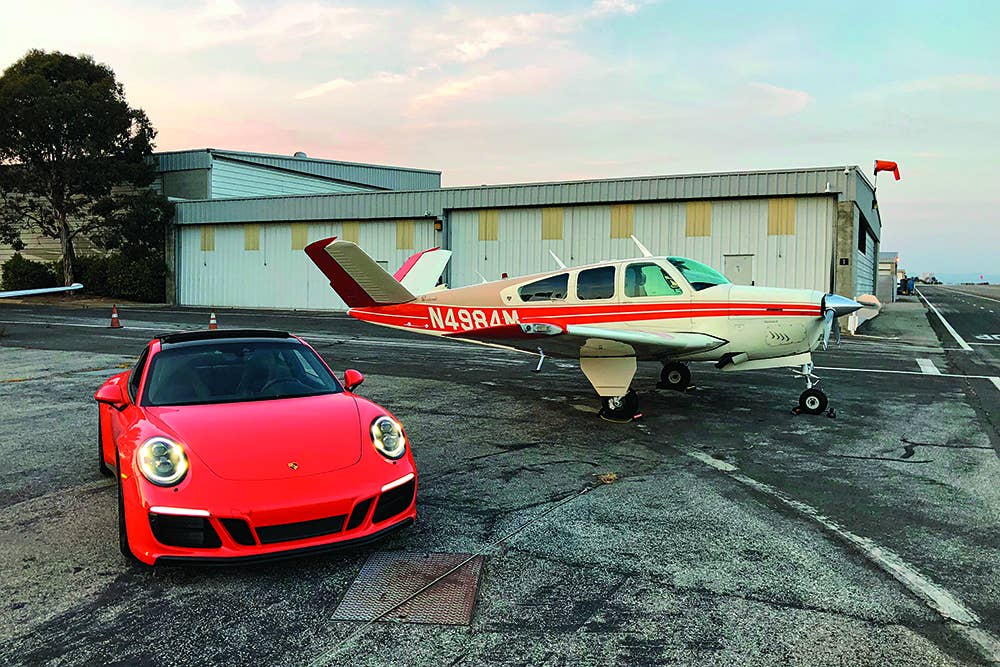In Aircraft and in Life, Craftsmanship Counts
The work of fanatical artisans wins over ‘fast and cheap’ every time.

The similarities between these machines helps make the writer’s point, beautifully. [Courtesy: Ben Younger]
The two machines pictured above do not conform to the rules of economy of scale. Both are made by hand to some degree, and done so to exacting tolerances in small numbers by dedicated craftsmen. Both have horizontally-opposed, six-cylinder engines. Both require a certain level of mastery to fully extract their potential. Both attract the mechanically zealous.
Both fly.
We are currently experiencing a profound loss of craft in our world. As a society we consume and we replace. We do not repair. There is no incentive to do so when goods are cheap. Efficiency has come to eclipse all other manufacturing qualities—most notably, quality. In this booming consumer culture, the individual artisan has been sidelined. There have always been exceptions, but they demand a higher price tag governed by the laws of volume. Beechcraft and Porsche are two companies that never lost the thread.
The Porsche 911 GTS and the Beechcraft Bonanza pictured were built 40 years apart on different continents. One in 1978. The other in 2018. One in Kansas. One in Stuttgart. But they were built by the same type of human—fanatical artisans. My people. Where some see a status symbol, I see functionality taken to its logical conclusion. I used to own the airplane while the car was generously loaned to me so I wouldn’t feel out of place driving around Hollywood (I own a RAM pickup back east).
Karl Marx wrote at length about the alienation of the worker.
“In your enjoyment, or use, of my product I would have the direct enjoyment both of being conscious of having satisfied a human need by my work, that is, of having objectified man's essential nature, and of having thus created an object corresponding to the need of another man's essential nature...Our products would be so many mirrors in which we saw reflected our essential nature.”
There is truth there.
Compare that to the worker on an assembly line who is estranged from the final product by means of extracting all of his potential in a repetitive movement. His labor is rewarded with a wage but he is removed from the satisfaction of completion because of his restricted role. Marx would argue this alienates him not only from his work but from himself. He is unable to fully express himself within the framework of those that hold the means to production.
No, I’m not a Communist. I am someone that wants a deeper connection to the things I purchase. And I want to maintain those things over time, not throw them away. My current Bonanza has the same birth year as me—1972. I plan on taking as much care of her as I do in me.
Yes, I understand the larger needs of the masses and the impracticality of one worker putting together my pickup truck. But it doesn’t mean we can’t appreciate the artisan’s contribution and try, where we can, to reward that work. I once bought a kitchen knife from Bob Kramer. He made the knife himself. He forged the carbon steel. He shaped and sharpened the blade, finally attaching a hand-carved wood handle at its completion. I never mention the knives I bought from Bed, Bath & Beyond to friends who visit my home. But everyone hears about the Kramer and the man behind it. I will pass the knife down to my children. They will in turn, tell Bob’s story. This is not insignificant.
“I am someone that wants a deeper connection to the things I purchase. And I want to maintain those things over time, not throw them away.”
As airplane owners we are privileged to live amongst craftsmen. I remember going into the shop at ACE Cylinders in Greeley, Colorado, when I had the engine in my airplane overhauled. Brian Rosin had the Continental 550 mounted on a stand in the middle of the room. He was alone and absolutely focused. I watched him measure, bolt, press and fit. Hundreds of pieces that needed to come together in the right order at the right tolerances with the right tools. The work he does and the skills used can not be acquired simply from text or an app. Brian learned from Joe Folchert, who in turn learned from a builder before him. Know-how is passed down in the oral tradition from one craftsman to another. Am I romanticizing it? Absolutely. Does that mean it doesn’t have real world value?
You don’t get to shake the hand of the individual who built your car’s engine. Not so with your airplane. Engine builders welcome you into their shops and these interactions are beneficial on all counts. Meeting the customer, the artisan sees where his hard work is going and enjoys the warm glow of recognition, thereby incentivizing him to continue to do good work. The pilot learns about her engine and the craftsmanship that went into building it. Leaving the shop she carries with her not just the engine, but a sense of comfort and security in knowing that an artisan put it together with care and deliberation. My contractor upstate is fond of saying “You can have it cheap, fast or well done. Pick two.” In aviation you can remove cheap and fast as options and that’s just fine. The stakes are that much higher in our world since you can’t pull over to the side of the road when something goes wrong flying an airplane. Brian’s artisanship is not only represented as a thing of beauty but also as an existential safeguard for my life. His work checks a lot of boxes.
We may be, however, witnessing a resurgence in craft and artistry. It is beginning to resurface in organic farming and manufacturing. Small batch and high quality. There is a thirst for it. People are beginning to recognize the value in something that was made with care by another human being. And there are signs that the corporations are listening. If you look at a motor in an AMG, the performance arm of Mercedes, you will find a plate attached to it with the signature of the craftsman who put that motor together.
Beechcraft was sold to Textron in 2013 and the Bonanza is barely holding on under its new corporate ownership. A certain unnamed manufacturer that rhymes with Kirrus introduced an airframe parachute system that obliterated all other sales of high-performance singles. Aside from avionics upgrades, the Bonanza has not functionally improved in many years now. Where there is no financial incentive, there is no innovation.
A publicly traded company cannot continue to produce machines at a loss. The trick is selling something else so profitable that it allows the artisans to continue their work unburdened by practical (read: economic) considerations. Porsche sells a lot of Cayennes and they make a lot of money doing so. And so the 911 lives on. I hope Textron can find a way to do the same so that my beloved Bonanza—the longest, continuously produced aircraft in the world—can continue its run. True artisans (and artists) are less concerned with economic outcomes. This is a good thing. They should spend their days dreaming and drafting. Who knows, maybe if Textron were to let those fanatical artisans loose they might innovate enough to both keep their artistry alive and make the corporations some money doing so. Crazy thought. I know.
Editor's Note: This article originally appeared in the Dec. 2021 issue of FLYING.

Sign-up for newsletters & special offers!
Get the latest FLYING stories & special offers delivered directly to your inbox






